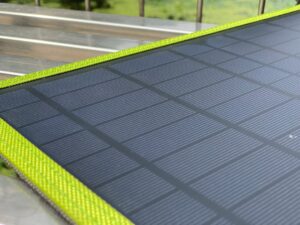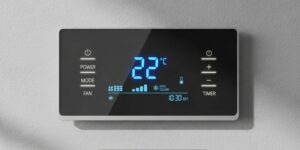Air infiltration refers to the unintentional or accidental introduction of outside air into a building through cracks, gaps, and openings in the building envelope. This phenomenon occurs when there is a difference in air pressure between the inside and outside of a structure, often driven by wind or temperature variations. As air moves in and out of a building, it can significantly impact indoor air quality, comfort levels, and energy consumption.
Understanding air infiltration is crucial for architects, builders, and homeowners alike, as it plays a vital role in the overall performance of a building. The concept of air infiltration encompasses various factors, including the materials used in construction, the design of the building, and the local climate. For instance, older buildings may have more significant air leakage due to wear and tear over time, while newer constructions often employ advanced sealing techniques to minimize such issues.
The measurement of air infiltration is essential for assessing how well a building retains conditioned air, which directly influences heating and cooling costs.
Key Takeaways
- Air infiltration refers to the unintentional leakage of air into and out of a building through cracks, gaps, and openings in the building envelope.
- Air infiltration ratings are important for determining a building’s energy efficiency and indoor air quality.
- Air infiltration can significantly affect a building’s energy efficiency by allowing conditioned air to escape and outdoor air to enter.
- The air infiltration rating scale measures the amount of air leakage in a building, with lower ratings indicating less leakage.
- Common sources of air infiltration include windows, doors, vents, and gaps in the building envelope.
Importance of Air Infiltration Ratings
Air infiltration ratings serve as a critical benchmark for evaluating the effectiveness of a building’s envelope in preventing unwanted air exchange. These ratings provide valuable information to builders and consumers about how well windows, doors, and other components resist air leakage. A higher rating indicates better performance, which can lead to improved energy efficiency and enhanced comfort within the living space.
Consequently, understanding these ratings is essential for making informed decisions when selecting building materials or renovating existing structures. Moreover, air infiltration ratings are increasingly becoming a focal point in energy efficiency standards and building codes. As awareness of environmental issues grows, many jurisdictions are implementing stricter regulations regarding energy consumption in buildings.
By adhering to these standards, builders can not only ensure compliance but also contribute to sustainability efforts. The importance of air infiltration ratings extends beyond mere compliance; they also reflect a commitment to creating healthier living environments by reducing drafts and improving indoor air quality.
How Air Infiltration Affects Energy Efficiency
The relationship between air infiltration and energy efficiency is profound. When outside air infiltrates a building, it can disrupt the carefully controlled indoor climate, leading to increased heating and cooling demands. For instance, during winter months, cold air entering through leaks can force heating systems to work harder to maintain comfortable temperatures.
Conversely, in summer, warm outdoor air can raise indoor temperatures, prompting air conditioning units to operate more frequently. This cycle not only results in higher energy bills but also places additional strain on HVAC systems. Furthermore, excessive air infiltration can lead to uneven temperature distribution within a building.
Some areas may become uncomfortably cold or hot due to drafts, while others may remain stagnant and poorly ventilated. This inconsistency can affect occupant comfort and productivity, making it essential for builders and homeowners to address air leakage issues proactively. By improving air infiltration rates, individuals can achieve significant energy savings while enhancing overall comfort levels within their spaces.
Understanding the Air Infiltration Rating Scale
| Rating | Air Infiltration (CFM/ft2) | Description |
|---|---|---|
| 1 | 0.40 | Very tight construction, almost no air infiltration |
| 2 | 0.40-0.60 | Tight construction, low air infiltration |
| 3 | 0.60-0.90 | Moderate construction, moderate air infiltration |
| 4 | 0.90-1.20 | Normal construction, moderate to high air infiltration |
| 5 | 1.20+ | Loose construction, high air infiltration |
The air infiltration rating scale is designed to quantify the amount of air that leaks through a building’s envelope under specific conditions. Typically measured in cubic feet per minute (CFM) per square foot of surface area at a pressure difference of 0.3 inches of water column (in w.c.), this scale provides a standardized way to compare different products and materials. A lower CFM rating indicates better performance in terms of air sealing, while higher ratings suggest greater potential for air leakage.
Understanding this scale is crucial for consumers looking to make informed choices about windows, doors, and insulation materials. For example, a window with an air infiltration rating of 0.1 CFM/sq ft is considered highly efficient compared to one rated at 0.5 CFM/sq ft. By familiarizing themselves with these ratings, homeowners can select products that align with their energy efficiency goals and contribute to long-term savings on utility bills.
Common Sources of Air Infiltration
Air infiltration can occur through various sources within a building’s structure. Common culprits include gaps around windows and doors, cracks in walls or foundations, and poorly sealed ductwork. These openings allow outside air to enter while conditioned air escapes, leading to inefficiencies in heating and cooling systems.
Additionally, electrical outlets and plumbing penetrations can also serve as pathways for unwanted airflow. Another significant source of air infiltration is the attic and roof areas. Poorly insulated or ventilated attics can lead to substantial heat loss during winter months and heat gain during summer months.
This not only affects energy efficiency but can also contribute to moisture problems and mold growth if not addressed properly. Identifying these common sources is the first step toward implementing effective solutions that enhance a building’s overall performance.
How to Measure Air Infiltration
Measuring air infiltration typically involves conducting a blower door test, which assesses the airtightness of a building by creating a pressure difference between the inside and outside. During this test, a powerful fan is mounted in an exterior doorway to draw air out of the building, lowering the internal pressure. This pressure difference causes outside air to flow into the building through any existing leaks, allowing for quantification of the total airflow.
The results from a blower door test provide valuable insights into a building’s performance regarding air infiltration. The data collected can help identify specific areas that require attention or improvement. Additionally, this testing method is often used in conjunction with thermal imaging cameras to visualize airflow patterns and pinpoint leaks more accurately.
By measuring air infiltration effectively, homeowners and builders can make informed decisions about necessary repairs or upgrades.
Factors Affecting Air Infiltration
Several factors influence the level of air infiltration within a building. One primary factor is the quality of construction; poorly installed windows or doors can create significant gaps that allow for unwanted airflow. Additionally, the choice of materials plays a crucial role; some materials are inherently more airtight than others.
For instance, high-quality weatherstripping can significantly reduce leaks around doors and windows. Environmental conditions also impact air infiltration rates. Wind speed and direction can create varying pressure differences across a building’s surface, leading to increased airflow through leaks during stormy weather.
Temperature fluctuations between indoor and outdoor environments further exacerbate this issue; as warm indoor air rises and escapes through leaks, it creates negative pressure that draws in cold outdoor air. Understanding these factors is essential for effectively managing air infiltration in any building.
Consequences of Poor Air Infiltration Ratings
Poor air infiltration ratings can lead to numerous negative consequences for both occupants and the building itself. One immediate effect is increased energy consumption; as conditioned air escapes through leaks, heating and cooling systems must work harder to maintain desired temperatures. This not only results in higher utility bills but can also shorten the lifespan of HVAC equipment due to excessive wear.
In addition to financial implications, poor air infiltration can adversely affect indoor air quality. Uncontrolled airflow may allow pollutants, allergens, and moisture from outside to enter the living space, potentially leading to health issues for occupants. Furthermore, excessive moisture intrusion can contribute to mold growth and structural damage over time.
Addressing poor air infiltration ratings is therefore essential for ensuring both comfort and safety within any building.
Improving Air Infiltration Ratings
Improving air infiltration ratings involves implementing various strategies aimed at sealing gaps and enhancing overall airtightness within a building’s envelope. One effective approach is weatherization, which includes applying caulk or weatherstripping around windows and doors to eliminate drafts. Insulating attics and crawl spaces can also help reduce heat loss while preventing moisture-related issues.
Another strategy involves upgrading existing windows and doors to more energy-efficient models with lower air infiltration ratings. High-performance products often feature advanced sealing technologies that significantly reduce leakage compared to older counterparts. Additionally, regular maintenance checks should be conducted to identify any new sources of leaks that may develop over time due to wear or environmental factors.
Regulations and Standards for Air Infiltration
As energy efficiency becomes an increasingly important consideration in construction practices, various regulations and standards have emerged regarding acceptable levels of air infiltration in buildings. Organizations such as the American Society for Testing and Materials (ASTM) provide guidelines for testing methods and performance criteria related to air leakage in building components. Many local building codes now incorporate specific requirements for air infiltration ratings as part of their energy efficiency mandates.
Compliance with these regulations not only ensures that buildings meet minimum performance standards but also promotes sustainable practices within the construction industry. Builders who prioritize adherence to these standards contribute positively toward reducing overall energy consumption on a larger scale.
Choosing Products with Good Air Infiltration Ratings
When selecting products for new construction or renovations, it is essential for homeowners and builders alike to prioritize those with good air infiltration ratings. This involves researching various options available on the market while considering factors such as material quality, design features, and manufacturer reputation. Energy-efficient windows and doors are often labeled with their respective air infiltration ratings prominently displayed on product packaging or specifications sheets.
By comparing these ratings across different brands or models, consumers can make informed choices that align with their energy efficiency goals while ensuring long-term comfort within their living spaces. Ultimately, investing in high-quality products with low air infiltration ratings pays off through reduced energy costs and improved indoor environments over time.
FAQs
What is an air infiltration rating?
An air infiltration rating measures the amount of air that can pass through a material or structure, such as windows, doors, or walls. It is typically measured in cubic feet per minute per square foot of material.
Why is air infiltration rating important?
Air infiltration can lead to energy loss, decreased indoor comfort, and increased utility costs. A lower air infiltration rating indicates that a material or structure is more airtight and can help improve energy efficiency and indoor comfort.
How is air infiltration rating measured?
Air infiltration rating is typically measured using a blower door test, which involves pressurizing or depressurizing a building to measure the amount of air leakage. The results are then used to calculate the air infiltration rating.
What are some common materials with air infiltration ratings?
Windows, doors, walls, and other building materials can have air infiltration ratings. Energy-efficient windows and doors, for example, often have lower air infiltration ratings to minimize air leakage.
How can air infiltration rating be improved?
Improving air infiltration rating can be achieved through proper installation, weatherstripping, caulking, and using high-quality, airtight materials. Regular maintenance and inspections can also help identify and address any air leakage issues.






